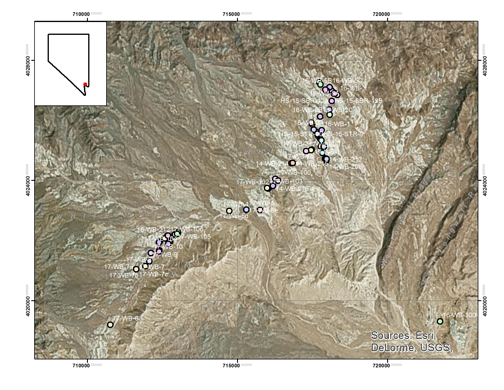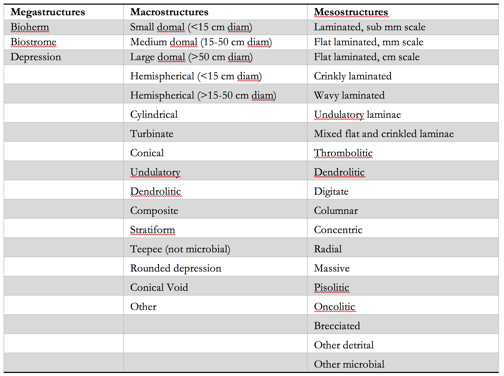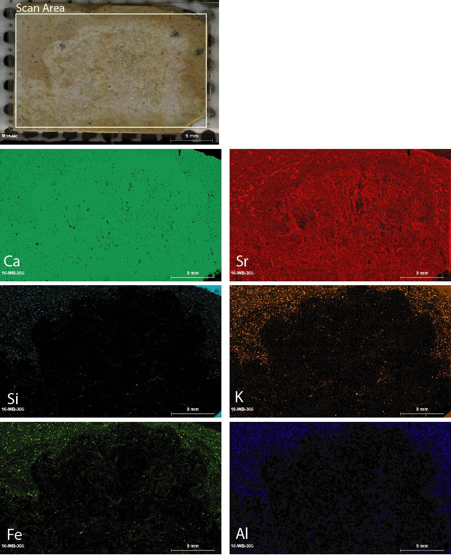Reports: UR854934-UR8: Reservoir Heterogeneity and Facies Characterization of Rift Basin Microbial Carbonate Lakes: Insights from the Miocene Horse Spring Formation and the Modern Lower Pahranagat Lake
Thomas A. Hickson, PhD, University of St. Thomas
We made excellent progress on both the Horse Spring and Lower Pahranagat Lake components and we are well on our way to accomplishing the major goals of the research.
Figure 1. Sampling localities in the White Basin for Upper Horse Spring Fm and example of use of microbialites database for lateral variation in lacustrine microbialites. Different colored dots represent different microbial macroform geometries.
Figure 2. Conceptual framework for our classification of microbialite structures and textures. Megastructures group into bioherms, biostromes, and depressions. Macrostructures are individual bioherms or strata bound beds with consistent internal textuers. Mesostructures are the textural elements that comprise macrostructures. Depressions labeled “Gorilla Beds” and “FRU” are informal field names that will be modified in future work.
Table 1. Microbialite textural classification embedded in our database.
Horse Spring Microbialites.
* March 2017 Fieldwork. The PI, along with students Bjorkman and Loveall, and project participant Eric Stevens (UST Geology Lab Coordinator), spent one week in the field mapping and sampling Lovell Wash Member (Upper Horse Spring Formation) microbialites in the White Basin and Lovell Wash syncline localities. In both of these localities we walked out especially microbialite-rich intervals, 1-10 m in thickness, to sample and document lateral variability in microbialite facies (Fig. 1).
* Development of a working Atlas of Lacustrine Microbialities. To support our database and research we have developed an atlas of microbial mega- and macrostructures based on our field data collection.
* Classification of microbialites textures and sedimentary structures (Fig. 2; Table 1). Having completed most of the fieldwork for this project and collected well over 100 samples, students Loveall and Bjorkman, along with Hickson and Stevens, began to systematize a classification of Horse Spring Formation microbialites at the macroscale. We have detected a range of macro- and mesoscopic textures in both stromatolites and thrombolites. Bjorkman and Stevens have concentrated their efforts on characterizing stromatolitic textures, whereas Loveall and Hickson have focused on thrombolites.
* Sedimentary petrography. Consistent with the multi-scale hierarchical approach that we are taking with microbialites, we have begun to characterize microscale textures in considerable depth.
* Scanning microXRF analyses. In late summer we began using a microXRF system at the Macalester College Keck Geochemistry Lab to characterize elemental variation within microbialites at the micro- and mesoscales. These analyses allow us to correlate specific texture and fabrics with geochemistry (Fig. 2). This is an exciting new path that we plan on pursuing more in the 2017-18 funding cycle.
* November 2016 Fieldwork. The PI, as part of his sabbatical, investigated microbialite localities in the Green River Formation in Wyoming and the Hot Springs Limestone in Idaho. These outcrops provide important context for the Horse Spring lacustrine microbialites and dovetail with our work with the Gustavus Adolphus College microbialites project.
Figure 3. microXRF elemental scans of small, lacustrine thrombolite. Full color scan of the sample is in upper left with scan area outlined. Elemental maps provided for select elements below. Note that Ca is poorly correlated with primary texures, whereas Sr strongly highlights the microbial textures. Si, K, Fe, and Al all occupy the zone outside of the main thrombolytic mound and are likely associated with siliciclastic clays.
Lower Pahranagat cores.
* November 2016 Pahranagat Coring Expedition. Our initial coring expedition the prior March was cut short due to high winds, so we were unable to get an overlapping core to cover gaps between core drives. We returned to the Lower Pahranagat Lake and collected these overlapping cores. Initial core processing (splitting, logging, digital imaging, and magnetics) were accomplished soon after at LacCore.
* Students Brundrett and Horns prepared and Theissen analyzed several hundred core subsamples for C and N analysis.
* Brundrett and Horns prepared approximately 80 samples for stable isotopic analysis which was completed at the University of Minnesota during spring 2017.
* Theissen subsampled the cores for radiocarbon age dating and this was completed at a private lab during spring 2017.
* Theissen trained student Duggan for additional work on C and N analysis and sedimentary microscopy during spring and summer 2017. Duggan completed C and N preparation and analysis during summer 2017.
Major impacts on PIs and Students
* The PI (Hickson), in collaboration with undergraduate students and scientific collaborators outside of this grant, has continued to develop database management and construction skills. We hope to be able to migrate our database to a web-based platform within a year and have been working with the structural geology project, StraboSpot (part of the NSF EarthCube program) to see if it is possible to convert our database to a graph database format that will integrate with this project.
* We continue to share data and insights with the microbialites research group at Gustavus Adolphus College under Julie Bartley’s supervision. This expands the reach of this PRF and that of Dr. Bartley both temporally and spatially. As part of this effort, Hickson has investigated lacustrine microbialite localities of the Green River Formation that are critical to Bartley’s group work.
* The research has directly impacted the learning of a sizeable group of undergraduate geoscience students. Five were directly involved as paid researchers on the project and they have developed considerable skill with field data collection, sample preparation, analysis, and interpretation.
* Though our connections with the Macalester College geology department we have begun to develop expertise in ?XRF scanning analysis of microbialites, a fairly new area of investigation that ideally supports this project.
* Hickson and Bartley (Gustavus Adolphus College) will be co-chairing a continental microbialites session at the Geological Society of American National Meeting in Seattle.















